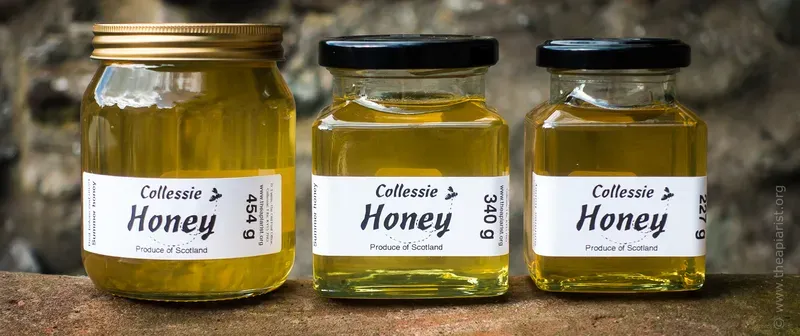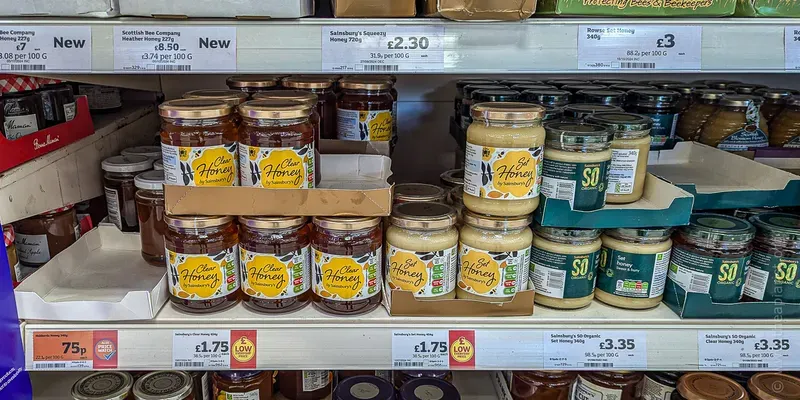Fake news

While discussing What is local? last week I touched on the subject of blended honey originating from more than one country. These usually carry wording similar to this:
Produce of EU and non-EU countries
If you think about it, that simple definition equates to precisely anywhere in the world.
Not a lot of help if you're interested in the provenance of the honey you buy.
Perhaps that's the idea?
Considering the font size this geographic 'origin' is usually printed, I've always assumed that the consumer was unlikely to have any interest in the provenance (or have much better eyesight than me).
Or, a cynic (who me?) might suggest, the producer or vendor does not want the consumer to easily find this information.
Whatever, perhaps it's only beekeepers that read the labels? I'm pretty certain it's only beekeepers that understand the significance of the wording on the labels.
Imported honey
We eat (or use, which includes re-exporting) a huge amount of honey in the UK annually. In fact, we use so much that domestic production, even if the consumer {{1}} wanted or could afford 'home grown' honey we couldn't meet the demand.
As a consequence, we import a lot of honey.
The UK is the world's fourth-largest importer of honey and second (by volume) to Germany in Europe. We're also third by value to Germany and France ... that means we import less expensive honey, but more of it.
In numbers, rather than ranking, the UK imports over 50,000 tons of honey annually, valued at about €122 million. Rowse Honey, who got a not entirely honourable mention last week, is probably the UK's largest importer.
Provenance ... which are these 'non-EU countries'
So where does all this honey come from? Of the €613 million of honey imports to Europe (I've not found a country-by-country breakdown for destination, but the following figures do include the UK) ~64% originate from just four countries; Mexico (8%), Argentina (10%), Ukraine (19% {{2}}) and China (27%).

At least, that's where the imported honey is labelled as originating. It's well known that some imports go via one or more intermediate countries to deliberately obscure the real origin.
In a way, the origin is irrelevant ... what matters is that a large volume of a relatively valuable product is being imported.
Inevitably, this means that some unscrupulous producers, importers or packers (aka crooks) see this as an opportunity to cut a few corners and make a quick buck.
Kerching
The average cost (€/kg) of Mexican, Argentinian, Ukrainian and Chinese imported honey was 3.67, 3.31, 2.63 and 1.58 (2022 prices).
For comparison, bulk UK prices were €4.36/kg {{3}}.
Kerching ... suddenly the potential for making a bit of additional profit becomes obvious. If you import 100 tons of 'Mexican' honey that's actually a 20/80 mix of Mexican and Chinese honey, there's a potential profit of about €170,000 to be made.
'Honey' or honey?
But sugar syrups made from corn, sugar cane, rice or sugar beet are a lot cheaper than honey of any sort.
My attempts to find real prices were underwhelming, but corn syrups appear to cost about $550-600 per ton ... about one third the cost of the cheapest imported honey. Therefore, potential profits are much larger if the honey is adulterated with sugar syrup.
I'll use 'honey' to indicate an adulterated product, mixed with syrup of some kind.
If you trust my maths (I don't 😉), a 20/80 adulterated mix of Mexican honey made up with corn syrup might generate a cool €250,000 profit for the adulterer.
Crime does pay.
Remember, those back of the envelope figures quoted above were for 100 tons of the stuff ... the UK imports over 50,000 tons per year.
This is a multi-million dollar industry ... and probably a multi-million dollar racket.
Honey is the one of the top three foodstuffs - together with olive oil and milk - that is traded fraudulently. Inevitably, there are attempts to identify adulterated honey, but the fraudsters are usually one or two steps ahead of the authorities. The latter need to develop assays capable of routinely and unambiguously discriminating between adulterated honey and the real thing ... when the real thing is itself a naturally variable product.
They then have to apply those assays and penalise the producers, packers and sellers that profit from dealing in 'honey'.
How can 'honey' be identified and distinguished from real honey?